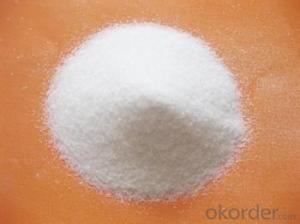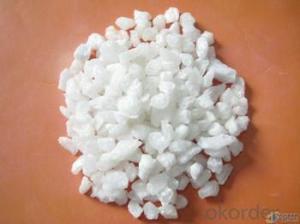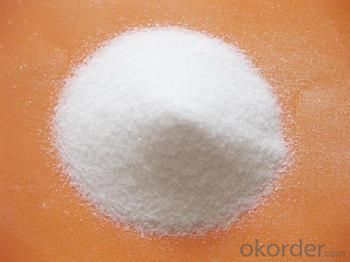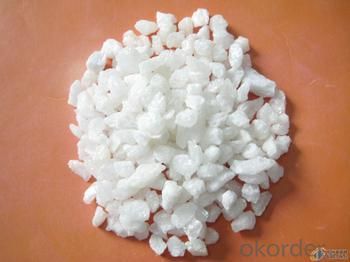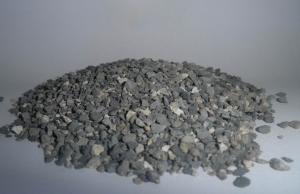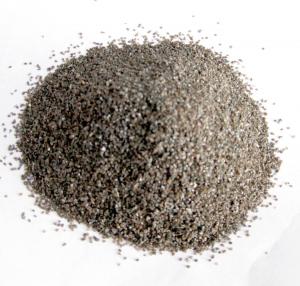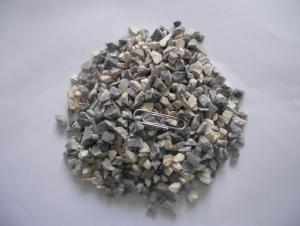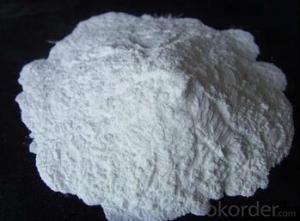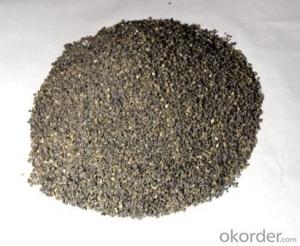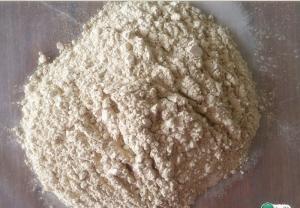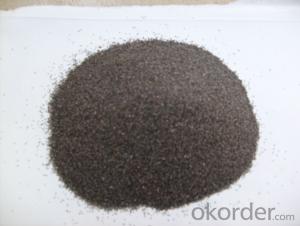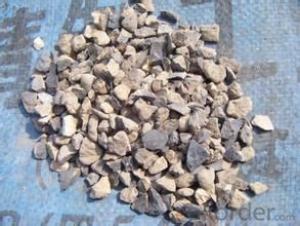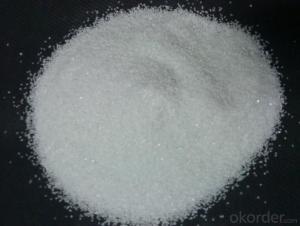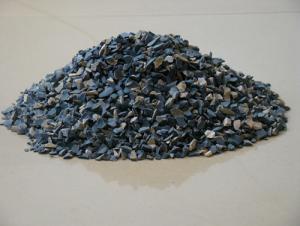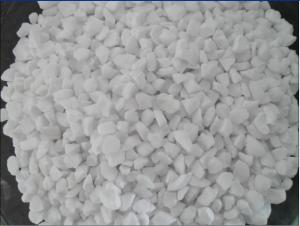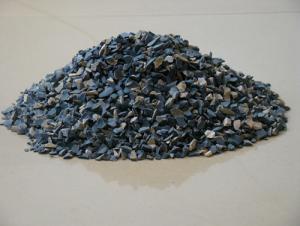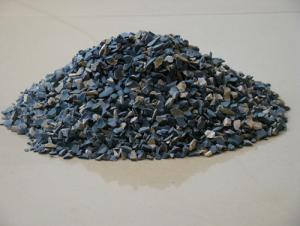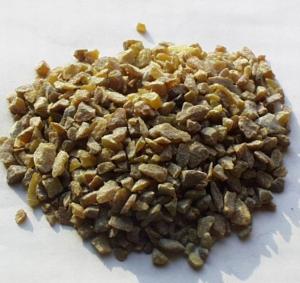Raw Materials for Refractory:White Fused Alumina 99%
- Loading Port:
- China Main Port
- Payment Terms:
- TT OR LC
- Min Order Qty:
- -
- Supply Capability:
- -
OKorder Service Pledge
OKorder Financial Service
You Might Also Like
Packaging & Delivery
| Packaging Detail: | 25kg bag or ton bag or as your requirement. |
| Delivery Detail: | within 20 days delivery after receipt of advance payment. |
Specifications
99% high purity abrasive White fused alumina for refractory
1.White fused alumina99%
2.Refractory: 0-1mm, 1-3mm, 3-5mm, 5-8mm
Products discription
1.Introduction
The main raw material of white fused alumina is high grade processed alumina, which is fused with the carbon material and scrap iron in the electic furnace under the high temperature of above 2200°C.The product is characterized by low expansion coefficient, high refractoriness, good thermal and chemical stability.
2. Grain size commonly used
Refractory: 0-1mm, 1-3mm, 3-5mm, 5-8mm ,200#-0, 325#-0.
Abrasives: F24-F60.
Sandblasting abrasive:F10-F240.
Precision casting: F80-100, F100-F120.
Ceramic & electronic polishing:F240-800.
3.Physical properties of White Fused Alumina
Item | Color | Color System | Mohs Hardness | Melting Temperature(°C) | Refractory Temperature(°C) | True Density( g/cm3) | Magnetic Material |
Specification | white |
trigonal system | min10 | 2250°C | 1900°C | min3.50 | max0.003%
|
4.Chemical index of White Fused Alumina
Purpose | Specification | Chemical composition(%) | Magnetic material content(%) | ||||
Al2O3 | Na2O | SIO2 | CaO | ||||
For abrasive | F | 12#—80# | min99 | max0.6 | max0.4 | max0.003 | |
90#—150# | min98.5 | max0.003 | |||||
180#—240# | min98.2 | max0.7 | max0.4 | max0.002 | |||
For refractory | Size sand | 0—1mm | min99 | max0.5 | max0.4 | max0.003 | |
1—3mm | |||||||
3—5mm | |||||||
5—8mm | |||||||
Fine powder | 200#—0 | min98.5 | max0.5 | max0.5 | max0.003 | ||
325#—0 | |||||||
- Q: How to divide the fire resistant level of EVB?
- According to the indicators of amount of smoke, heat value, burning rate, and ignition point, combustion performance insulation materials are divided into A (non-combustible), B1 (flame retardant), B2 (flammable), B3 (combustible). It can be divided into the organic and inorganic types: The organic includes polyurethane and polystyrene board, the inorganic the includes glass wool and rock wool. The price of organic is lower, and it is combustible materials, it will produce hydrogen cyanide and other toxic gases when burned, the inhaled would die. The inorganic material is completely non-combustible insulation material.
- Q: How can refractory materials be divided?
- There are many criteria for the classification of refractories.Just referring to a book about refractory.
- Q: How much is the content of boron carbide in refractory material?
- Boron carbide is used in refractory material. For example, generally we could add 0.2% of boron carbide into magnesia carbon bricks. It is suggested that 0.5% is enough, because it has strong effect in boosting melt. It is said that 0.5% would be alright since boron oxide after oxidation belongs to material of low melting point, so the amount should be limited within 0.5%-1%,
- Q: What are the differences and connections between softening temperature of the refractory under a fixed load and thermal resistant creep property of the refractory?
- The result of refractoriness under load is temperature while the result of creep is percentage of deformation. Refractoriness under load and creep can be tested by an instrument. Refractoriness under load reflects the temperature in which the deformation reaches a certain degree under the condition of load. Creep reflects the deformation refractory has under the condition of constant temperature and load. Both refractoriness under load and creep are important criterion for the operating temperature of refractory.
- Q: What are grade classifications of the external walls for fireproofing?
- The basic level can be divided into: A1, A2, B1, B2, B3 and other levels. There are many technical indicators to make specific division, but I partly cannot report for a while, because it is very professional and technical. Please contact Qingdao Shanfang Instrument Co., LTD for details, they specialized in the external wall thermal insulation materials fire?rating testers.
- Q: What kind of refractory materials are used in the intermediate frequency furnace?The domestic boric acid can be used as a lining?, how much is the rate?
- Acid, neutral, basic and composite materials are used in intermediate frequency furnace. Domestic boric acid is practicable. The ratio is to determined combined with material, steel (iron) species, smelting temperature, current and other factors
- Q: Who knows the external wall thermal insulation materials fire rating requirements?
- The requirements of Department of Housing and the Ministry of Public Security No. 46: Residential buildings: the height of building is greater than 100 meters, the combustion performance of insulation materials should be level A. The other civil buildings: 24≤ height
- Q: What are the types of steel refractory materials
- The major category is classified as permanent layer, working lining. Specific varieties: Air permeable brick (corundum). steel ladle brick (magnesia or corundum), permanent layer castable (high alumina), reinforcing material for ladle bottom, repair material for the edge of tank and so on.
- Q: how does the fire endurance of first rate fire resistant window?
- how does the fire endurance of first rate fire resistant window? I really don't know it and I need a specific direct and detailed answer!
- Q: What is glass furnace used high-grade refractory materials?
- Corundum brick, such as alumina hollow ball brick. In addition, in the key parts of the glass furnace needs to use chromium zirconium corundum material. I'm salesman of zibo lei bao refractories company. The softening temperature of corundum mullite brick is 1500 degrees. So glass melting furnace needs to use refractory materials which high temperature resistance is more than 1600 degrees.
Send your message to us
Raw Materials for Refractory:White Fused Alumina 99%
- Loading Port:
- China Main Port
- Payment Terms:
- TT OR LC
- Min Order Qty:
- -
- Supply Capability:
- -
OKorder Service Pledge
OKorder Financial Service
Similar products
Hot products
Hot Searches
Related keywords
